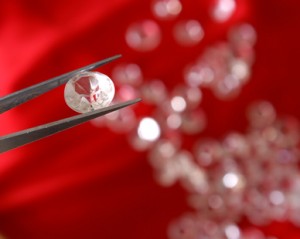 Do you know that if a diamond looks unclean, this is not necessarily because it is dirty? Let’s see how you can identify why some diamonds seem dirtier than others, and what you can do about it.
Do you know that if a diamond looks unclean, this is not necessarily because it is dirty? Let’s see how you can identify why some diamonds seem dirtier than others, and what you can do about it.
Why Do Some Diamonds Look Dirty?
There are two main reasons why a diamond may look dirty: Its surface could have accumulated dust and other dirt particles, or it could have a lot of small natural flaws inside that spoil its appearance.

Diamonds with dirt on them: It is very easy for dirt to accumulate on the surface of a diamond, especially if it has not been cleaned for a long time.
And the oils from your hands, which remain on the stone when you touch it, actually help the dirt particles stick.
Often, the dust on the diamond forms a thin layer that obstructs light from entering the stone, and as a result, it starts to look dark and grimy.
Take a closer look at your diamond. If you can remove some of the surface dirt by rubbing with a soft, damp cloth, then the diamond is simply dirty, not looking unclean because of internal flaws.
Diamonds that look dirty because of inclusions: Sometimes, diamonds are not really dirty, but they look that way because there are a lot of inclusions in them. This is often the case when the diamond has many carbon spots inside, which look like black dots.
To find out whether your stone looks dirty because it is included, it is best to clean it first and see if it still looks unclean.
Look at the diamond from a close distance, preferably using a loupe. If you can see many small dark spots inside or flaws that look like cracks and lines, then perhaps they spoil the diamond’s appearance, and dirt is not the real problem.
How to Remove Dirt from Diamonds
Taking care of diamonds is not really hard.
It is important to keep your stones clean because when dirt accumulates, it reduces their brilliance, and their internal flaws and yellow tints (if any) can become more visible because there is less sparkle to hide them.
First, prepare a cleaning solution by mixing warm water with a little mild soap or a drop of dishwashing liquid.
Then soak the stone in the solution for about five to ten minutes.
Scrub the diamond gently with a soft brush until the stone is clean.
Finally, rinse it with clean water, and wipe the diamond with a soft cloth.
What to Do with “Dirty” Diamonds of Low Clarity
It’s clear what you should do if your diamond is dirty, but what about those stones whose unclean look is due to low clarity and lots of inclusions?
There are several ways to conceal that “dirty” effect, although your success may vary depending on the clarity grade of the stone and the position of the inclusions.
Put the diamond in a setting that increases light entry. The more light enters a stone, the higher its brilliance, and as already mentioned, brilliance can help mask diamond imperfections.
In general, prong settings allow the most light to enter the diamond, and fewer prongs (four or six) are preferable if you want maximum brightness.
Full bezel settings and channel settings, on the other hand, hide a greater portion of the stone.
Position the diamond in the setting so as to hide inclusions. This would be most effective if the inclusions are concentrated only in some parts of the stone, and the further from the center, the better.
Ask the jeweler who is setting your diamond to do his or her best to conceal the more visible flaws with the setting’s prongs or bezels, if possible.
Keep the diamond clean. We already mentioned that cleanliness affects brilliance, as well as what effect it has on clarity. This is why cleaning a low-clarity stone regularly is very important, as keeping its sparkle alive can make inclusions less visible.
This is also why it is a good idea to put such a stone in a setting that makes cleaning easier (e.g., a prong setting).
And last but not least, if you have to buy a “dirty” diamond with lots of small inclusions, it is best if its cut is of top quality. This way, the brilliance of the stone will be maximized, and the visibility of its flaws will be diminished as much as possible.
Source: http://www.jewelrynotes.com/diamonds-that-look-dirty-what-to-do-with-them/

